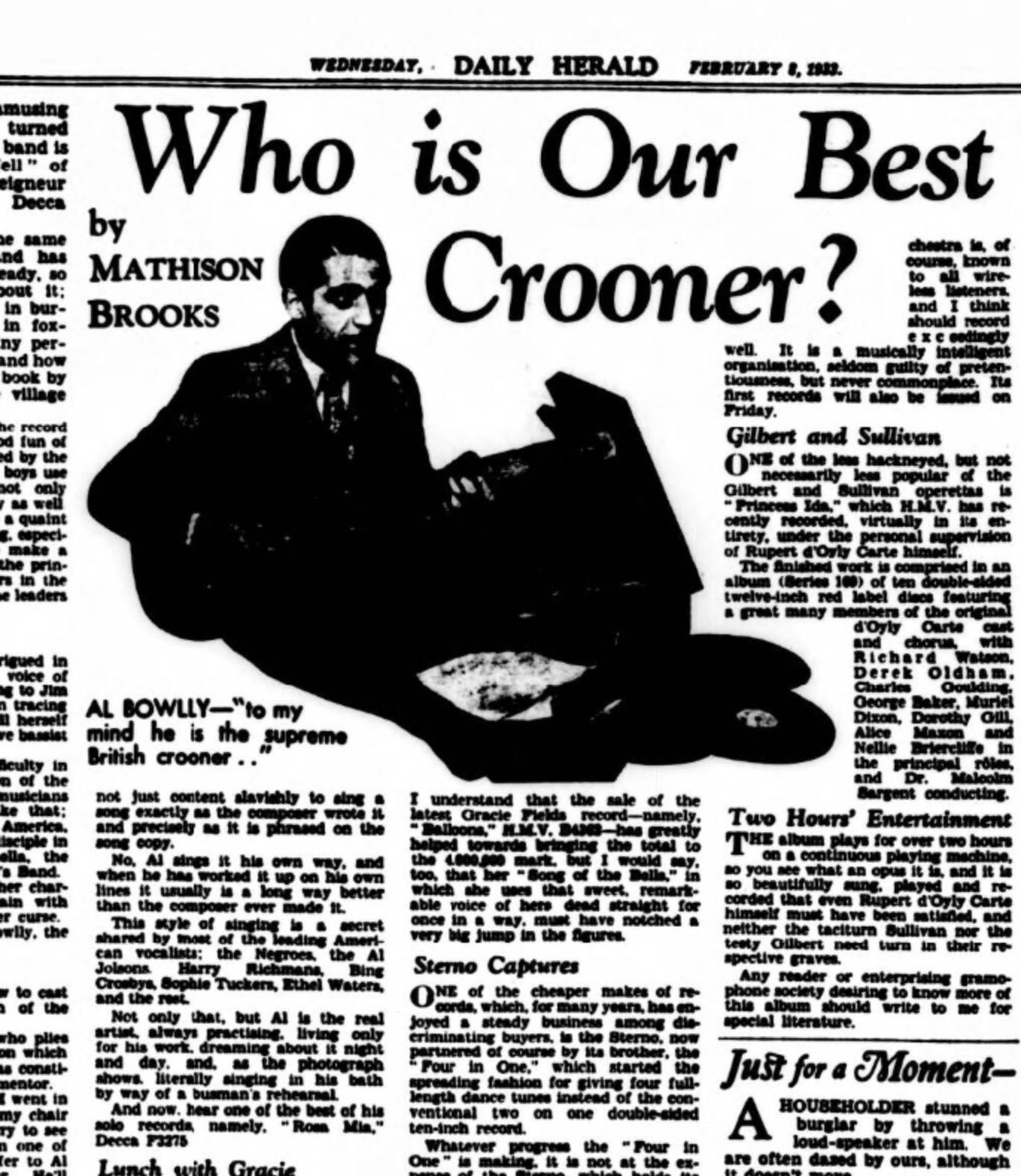“Who is Our Best Crooner ?”
One of the most amusing novelties ever turned out by a dance band is the ” Little Nell ” of Lew Stone and the Monseigneur Band, now issued on Decca F 3394. It is. of course, just the same ” production ” as the band has broadcast many times already, so you probably know all about it: how, for instance it tells in burlesque form and strictly in fox-trot rhythm, of the villainy per-formed against Little Nell and how that villainy is brought to book by the aged father and the village “constabule.” Neither on the air nor on the record do you enjoy the supreme good fun of hearing this number as worked by the band in person. for then the boys use props on the job and it not only sounds funny but looks funny as well
However, the record is such a quaint one as to be well worth having, especially by the collectors who make a hobby of knowing all about the principal rank and file performers in the star dance bands as well as the leaders themselves.
What’s in a Voice?
Such as these will be intrigued in recognising the quavery voice of Little Nell’s father as belonging to Jim Easton, the sax player and in tracing the piping treble of Little Nell herself to Tiny Winters, the diminutive bassist of the band.
Nor will they have any difficulty in identifying the bucolic diction of the ” constabule ” Only two musicians have a frog in the voice like that: one is Louis Armstrong. in America, and the other is his faithful disciple in England ,namely Nat Gonnella, the trumpet player of Lew Stone’s Band.
There remains only one other character to be solved—the villain with the dirty voice and the dirtier curse. Yes. it is Al Bowlly—Al Bowlly. the crooner.
The Barber’s Bias
It seems all wrong somehow to cast a crooner as the villain of the piece – yet I don’t know.
A certain tonsorial artist who plies an artistic scissor In the saloon which I favour for my hair cuts has constituted himself my guide and mentor.
Only a few days ago. when I went in for a trim, he came over to my chair and said gravely. ” I was sorry to see you make such a bloomer In one of your recent articles as to refer to Al Bowlly as the senior crooner. He’ll never be that Sir , What about Sam Browne? There’s a real singer.”
We debated the point and then he finished off the discussion by saying ” After all, when it comes to singing dance songs, there’s only one artist worth talking about – Bing Crosby. And If you want to do your readers a real service. you’ll tell them to get his “Brother ,Can You Spare a Dime?’”
In Defence of Bowlly
Well as far as Bing Crosby is concerned I am quite in agreement with all that, and the record in question is Brunswick 1434 , so hear the record and find out from it not only what good popular song singing is like, but also what America has come to with its unemployed millions, bread queues and the like.
But I am still unrepentant about Al Bowlly. To my mind he is the supreme British crooner, although, to tell the truth. there is Latin blood in his veins as you would suspect from his swarthy complexion ,large dark brown eyes, sideboard whiskers, and the extra ‘”l” in his surname.
Bowlly sings like a musician. He is not just content slavishly to sing a song exactly as the composer wrote it and precisely as it is phrased on the in song copy.
No ,Al sings it his own way and when he has worked it up on his own lines it usually is a long way better than the composer ever made it .
This style of singing is a secret shared by most of the leading American vocalists: the Al Jolson’s, Harry Reichmann’s , Bing Crosby’s , Sophie Tuckers, Ethel Waters and the rest .
Not only that, but Al is the real artist always practicing, living only for his work ,dreaming about it night and day and as the photograph shows ,literally singing in his bath in by way of a busman’s rehearsal.
And now. hear one of the best of his solo records, namely “Rosa Mia.” Decca F3275
